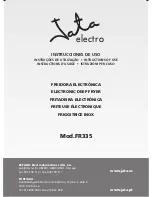
CLEANING
Translation of the original instructions
22
7 CLEANING
7.1
Routine cleaning
Caution
The use of flammable fluids to clean the appliance is forbidden
To ensure hygiene and the durability of the appliance, perform external cleaning on a regular basis, taking
care not to damage the cables and the electrical connections. Before starting cleaning, disconnect the
appliance from the power supply. Parts in steel can be washed with warm water and a neutral detergent:
Rinse them thoroughly to eliminate all traces of detergent and then dry with a dry cloth. Do not use abrasive
and corrosive detergents. Enamelled parts must be washed with soapy water. For appliances that included
an oven, cleaning it is made easier by removing the support grid. Thorough, daily cleaning prevents faults
and accumulated deposits of fat and/or food. The steels used in the manufacture of professional equipment
are tried and tested materials of the highest quality. Thanks to their characteristics, they are ideal materials
for use with food substances.
Consequently, when using stainless steel appliances, the following suggestions must be observed:
·
Stainless steel surfaces must always be kept clean, also ensuring contact with the air. The lack of oxygen
under layers of scale, starch, egg white or other deposits means that surfaces can be affected by
corrosion
·
Do not use products containing salt or sulphuric acid to remove scale. Suitable products are available
commercially but a diluted solution of acetic acid can also be used
·
To clean STAINLESS STEEL appliances, it is advisable to use detergents specifically formulated for this
material. For "minor cleaning", a mild washing up liquid solution may also be used
·
Do not wash the appliance with jets of water under pressure
·
Avoid using detergents containing abrasive powders or bleaches of any kind
·
Lockable stainless steel appliances, during periods of inactivity, must be left uncovered so that air can
freely access internal metal surfaces
·
Stainless steel must not remain in contact for long periods with concentrated acids or with aromatised
concentrates such as salt solutions, mustard, spice mixtures or the like. At certain temperatures and
concentrations, these substances can damage the passive layer. Contact surfaces must therefore be
immediately rinsed with clean water and then dried
·
It is inadvisable to use stainless steel pots exclusively to cook foods in salt water (pasta, rice, potatoes,
etc.). From time to time, these pots must also be used to cook foods containing fats or vegetables. This
helps to prevent damage caused by corrosion
·
After cooking foods in salt water, rinse the tanks with fresh water since salt water residues from cooking
form layers of highly concentrated saline solution that can cause spotting corrosion
·
To prevent so-called secondary corrosion, prolonged contact of stainless steel with ferritic steels should
be avoided
·
Any secondary corrosion spots must be eliminated immediately
·
Do not use sharp objects that may scratch stainless steel parts and consequently give rise to
deterioration

































